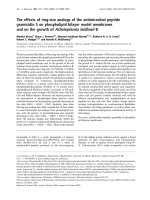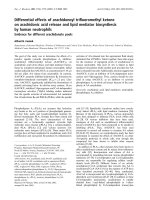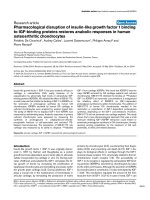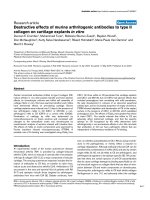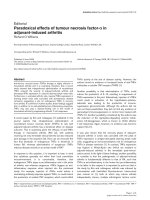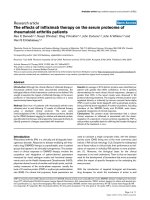Báo cáo y học: "Pharmacological effects of Radix Angelica Sinensis (Danggui) on cerebral infarction" docx
Bạn đang xem bản rút gọn của tài liệu. Xem và tải ngay bản đầy đủ của tài liệu tại đây (233.12 KB, 5 trang )
REVIEW Open Access
Pharmacological effects of Radix Angelica Sinensis
(Danggui) on cerebral infarction
Yi-Chian Wu
1
and Ching-Liang Hsieh
1,2,3*
Abstract
Radix Angelica Sinensis, the dried root of Angelica sinensis (Danggui), is a herb used in Chinese medicine to enrich
blood, promote blood circulation and modu late the immune system. It is also used to treat chronic constipation of
the elderly and debilitated as well as menstrual disorders. Research has demonstrated that Danggui and its active
ingredients, as anti-arthrosclerotic, anti-hypertensive, antioxid ant anti-inflammatory agents which would limit platelet
aggregation, are effective in reducing the size of cerebral infarction and improving neurological deficit scores.
Background
Danggui, the dried root of Angelica Sinensis (Radix
Angelica Sinensis), is a commonly used Chinese medic-
inal herb to enrich blood, promote blood circulation and
treat b lood defic iency pattern and m enstrual disorders
such as dysmenorrhea and irregular menstrual cycle [1].
Wilasrusmee et al. [2] reported that Danggui (105 μg/ml)
plays an immunostimulatory role in m itogen-stimulated
murine lymphocytes in vitro. A ngelan, a purified polysac-
charide component of Angelica nakai thought to improve
immune function, increases the expression of cytokines
in splenocytes as Angelan enhances and the production
of int erleukin-6 ( IL-6) and interferon- g(IFN-g)ofacti-
vated macrophages, helper T cells and natural killer cells
[3]. The chemical constituents of the Danggui extract are
classified into essential oil and water soluble parts includ-
ing lipid compounds, phenol ic co mpounds, car bohy-
drates, organic acids and other constituents [4]. The
most active ingredients are polysaccharides, Z-Ligustilide
(3-butylidene-4,5-dihydrophthalide) and ferulic acid (4-
hydroxy-3-methoxycinnamicacid) [1].
This article aims to provide an overview of the pharma-
cological effects of Danggui in reducing the size of cerebral
infarction and improving neurological deficit scores.
Search strategy
We searched Medline, PubMed, Cochrane Library and
the China National Knowledge Infrastructure (Chinese
language database) between 1990 and 2010, using
‘Angelica sinensis’, ‘Danggui’, ‘Angelica polysaccharides’ ,
‘ Z-Ligustilide’ , ‘Ferulic acid’ and ‘ Ischemic stroke’ as
keywords.
Vasodilation and improving microcirculation
Nitric oxide (NO) is synthesized with nitric oxide synthase
(NOS) which includes three different isoforms, namely
endothelial NOS (eNOS), neuronal NOS (nNOS) and
inducible N OS (iNOS) [5] . While nNOS and eNOS are
induced under different conditions, their activation relies
on intracellular Ca
2+
for binding calmodulin [5,6]. Due to
its vasodilative effects, eNOS is considered neuro-protec-
tive [6]. Hyperten sion and a lack of endothelium-derived
relaxing factor activity are found in eNOS knockout mice
[7]. Mo reover, the cerebral infarction size is larger in a
model of eNOS mutant mice with middle cerebral artery
occlusion (MCAo) [8]. Therefore, eNOS has a vasodilation
effect and is neuro-protective by increasing the blood flow
[9]. It is possible that Danggui increases NO formation
and relaxes the endothelium [10], thereby limiting infarc-
tion size . I n rabbits on a high-lipid diet, treatment with
ferulic acid, an active component of Danggui, increases the
generation of NO, thereby inhibiti ng platelet aggregation
on endothelium and proliferation of smooth muscles and
preventing leucocytes adhering to the endothelium [11].
Z-Ligustilide (3-butylidene-4,5-dihydrophthalide), a com-
ponent of Danggui, inhibits (4-8 μg/ml) the spontaneous
contraction of isolated rat uterus in a dose-dependent
manner [12]. Moreover, Z-Ligustilide may also inhibit
prostaglandin F-2a, oxytocin, acetylcholine chloride and
potassium depolarization-induced uterine contraction,
* Correspondence:
1
Department of Chinese Medicine, China Medical University Hospital,
Taichung 40402, Taiwan
Full list of author information is available at the end of the article
Wu and Hsieh Chinese Medicine 2011, 6:32
/>© 2011 Wu and Hsieh; licensee BioMed Central Ltd. This is an Open Access article distributed under the terms of the Creative
Commons Attribution License ( , which permits unrestricted use, distribution, and
reproduction in any medium, provided the original work is properly cited.
suggesting that Ligustilide modulates the function of uter-
ine tissue and has a non-specific anti-spasmodic effect [12].
Z-Ligustilide enhance s the recovery of conjunctival capil-
lary and venue diameter after dextran T500 administration
to rabbits and increases the number of opened capillaries
as well as blood flow, suggesting that Z-Ligustilide
improves microcirculation [13].
Ferulicacidisthemainorganicacidcomponentof
Danggui. Ferulic acid (10
-3
mol/L) relaxes the phenylephr-
ine-induced contraction of aorta ring in spontaneous on
rat (SHR) whereas the effects of ferulic acid m ay be
partially blocked by pret reatment of the aorta with N
G
-
nitro-L-arginine methyl ester (L-NAME, 10
-4
mol/L)
which inhibits the production of NO from L-arginine [14].
Ferulic acid (10
-3
mol/L) reduces the production of throm-
boxane B
2
in the aorta ring of SHR [14]. Ferulic acid (10
-4
mol/L) also significantly reduces the generation of
NADPH-dependent production of the superoxide anion
[14] and enhances the acety lcholine-in duced vasodilation
whereas hydroxyhydroquinone (HHQ) inhibits this effect
[14]. Taken together, ferulic acid reduces blood pressure
in SHR via effects on (1) eNOS; (2) the inhibition of
thromboxane B
2
to relax aorta ring; (3) reactive oxygen
species (ROS) scavenging activity to increase the availabil-
ity of NO in endothelial cell of aorta [14].
Anti-arthrosclerosis effects
Strok e is divided into two m ajor groups according to the
cerebral damage, cerebral infarction and cerebral hemor-
rhage. Eighty percent (80%) of stroke patient suffer from
cerebral infarction [15] . Cerebral infarction is mainly
caused by thrombosis, embolism or systemic hemody-
namic hypertension. At herosclerosis in large and small
arteries is a major contributor to cerebral thrombosis. The
etiology of atherosclerosis and stroke is related to inflam-
mation and genetic factors. Ischemic c erebral infarction
may be p revented by anti-inflamm atory agents o r the
treatment of vascular diseases, heart diseases and hyper-
tension [16-18].
A principal contributor to cerebral infarction and ather-
osclerosis is believed to be initiated by an excessive inflam-
matory-fibro-proliferative response [19]. Atherosclerosis
involves growth factors, cytokines and vaso-regulatory fac-
tors such as vascular endothelial growth factor (VEGF),
fibroblast growth factor (FGH), transf orming gro wth fac-
tor-b (TGF-b), interleukin-1 (IL-1) and tumor necrosis
factor -a (TNF-a) [1 9,20]. Cytokines are both pro- and
anti-atherogenic; for example, IL-1 and TNF-a mediate
the production of monocyte chemoattractant protein-1
(MCP-1) to induce monocyte migration directly into the
intima. By contrast, cytokines can induce NO production
which regulates the vasomotor tone of artery, thereby
influencing the initiation and progression of the
atherosclerosis process [20 ]. A previous study [21] found
that nicotine can mediate the development and progres-
sion of atherosclerosis via the inhibition of TGF-b1and
basic fibroblast growth factor (bFGF). The alteration of
TGB-b activity leads to the atherosclerotic change of ves-
sel wall and increased TGB-b signaling plays a protective
role of atherosclerosis [22]. A study [23] reported that
bFGF enhances smooth muscle migration and prolif era-
tion via the regulation of interstitial collagenase expression
in the early stages of atherosclerosis. Wang et al. [24]
found that the levels of TGB-b reduced and those of bFGF
increased in human umbilical vein endothelial cells
damaged by hyperlipidemic serum. Moreover, under elec-
tromicroscopy the morphology of endothelial cell was also
damaged which was reversed by Danggui (20 mg/ml) and
its component of sodium ferulate (0.3 mg/ml). These
results indicate that both Danggui and sodium ferulate
have anti-atherogenic effects [24]. Yu et al. [25] found that
the level s of total ch olesterol (TC, 0.95 mmol/L vs.11.79
mmol/L), triglyceride (TG) and high density lipoprotein
cholesterol (HDLC) and low density lipoprotein choles-
terol (LDLC) increased in rabbits on a high-lipid diet com-
pared to the control group which was on a normal diet.
After 25% Danggui was administered (i.v.) for four weeks,
the levels of TG decreased from 3.52 mmol/L to 1.68
mmol/L. The plaque area of thoracic aorta was also
reduced after Danggui treatment, from 63.31% to 35.58%
[25]. Moreover, Danggui reduced the increase of the
serum malonyldialdehyde (MDA) levels caused by the
high-lipid diet [25]. In a similar study [11], after treatment
with sodium ferulate, the plaque area of thoracic aorta was
reduced while the TG le vel was reduced to 1.75 mmol /L
in rabbits on a high-lipid diet [11]. Moreover, the sodium
ferulate-treated group i ncreased the production o f NO
from epithelium cells. Both Danggui and sodium ferulate
inhibit the formation of atherosclerosis be cause Danggui
reduces the TG and lipid peroxidation levels or increases
NO production, or both.
Anti-platelet aggregation effects
Anti-platelet aggregation agents such as aspirin, ticlopidine
and clopidogrel are widely used to prevent secondary
ischemic stroke [16,26]. A clinical trial [26] reported that
administration of aspirin within six hours of th e onset of
ischemic stroke reduces the patients’ mortality rate.
Danggui dose-dependently inhibited adenosine dipho-
sphate (ADP)-induced platelet aggregation and collagen-
induced platelet [27]. Danggui (20 g/kg) reduced platelet
aggregation by 87.9% in rats with ADP-induced platelet
aggregation and 33.0% in rats with collagen-induced pla-
telet aggregation [27]. Administration of sodium ferulate
(0.2 g/kg, i.v.) reduced ADP-induced platelet aggregation
by 38% in rats while a low er dose (0.1 g/kg) reduced
Wu and Hsieh Chinese Medicine 2011, 6:32
/>Page 2 of 5
collagen-induced platelet aggregation by 81% [27]. In an
arteriovenous shunt rat model, the wet weight of the
thrombus was reduced to 19.5 mg (46.4 mg in the con-
trol) in rats administered with Z-Ligustilide (10 mg/kg,
p.o.) and 13.6 mg in rats administered with more Z-
Ligustilide (40 mg/kg, p.o.) [28]. The maximal platelet
aggregation was 6.8% and 2.0% in the 10 mg/kg and 40
mg/kg groups respectively while the control was 44.6%
[28]. Compared with warfarin (1.0 mg/kg, p.o.), Z-Ligus-
tilide (10 mg/kg and 40 mg/kg) administered orally for
three days did not increase activated partial thrombo-
plastin time (APTT) and prothrombin time (PT) in a
coagulation time test ex vivo [28]. Danggui and Z-Ligus-
tilide exert anti-platelet aggregation effects.
Anti-inflammatory effects
Pro-inflammatory cytokines, such as IL-1b and TNF-a,are
increased i n the brain tissue of transient middle cerebral
artery occlusion (MCAo) rats [29,30]. IL-1 up-regulates
the expression of adhesion molecules such as intercellular
adhesion molecu le-1 (ICAM-1), P-selectin and E-selectin
in the endothelium [31,32]. These adhesion molecules
facilitate the translocation of activated leukocytes into the
ischemic core [31,32]. Moreover, n uclear factor-B(NF-
B) is also activated in the ischemic core [32]. Both
Sophora japonica L. and paeoniflorin inhibi t IL-1b secre-
tion, thereby reducing cerebral infarction size and neuro-
logical deficit [29]. Moreover, paeoniflorin reduces IL-1b,
TNF-a,ICAM-1andleucocytes[30].Therefore,anti-
inflammation, such as inhib ition of pro-inflammatory
cytokine and ICAM-1, is very important in treating cere-
bral infarction.
Ferulic acid (eg 80 and 100 mg/kg, i.v.) reduces the size
of cerebra l infarction and neurological deficit scores and
inhibits ICAM-1 and NF-B expression in transient MCAo
rats [33]. The anti-inflammatory action of ferulic acid is, at
least in part, important in its therapeutic effect on cerebral
infarct [33]. Moreover, ferulic acid (eg 100 mg/kg, i.v.)
exerts anti-inflammatory action by reducing the generation
of 4-hydroxy-2-nonenal (4-HNE), 8-hydroxy-2’-deoxygua-
nosine (8-OHdG) and apoptosis in the reperfusion period
after cerebral ischemia, thus providing neuroprotection
[32]. This neuro-protection by ferulic acid is thought to
occur via enhancing gamma-aminobutyric acid type B1
(GABA
B1
) receptor expression to against p38 mit ogen acti-
vated protein kinase (MAPK)-mediated NO-induced apop-
tosis [34]. Danggui reduces inflammatory cell infiltration
and TNF-a and TGF-ß1 mRNA expression; it also reduces
TNF-a and TGF-ß1 positive cells in radiation-induced
pneumonitis in mice [35]. Danggui polysaccharides reduce
TNF-a levels in the colon mucosa during intra-colon
enema with 2,4,6-trinitrobenzene sulfonic acid (TNBS) and
ethanol in rats [36]. Both Danggui and ferulic acid exert
anti-inflammatory effects.
Anti-oxidative effects
Reactive oxygen species (ROS) including the superoxide
anion, hydrogen peroxide and hydroxyl radical are gener-
ated after cerebral ischemia. The ROS affect mitochondrial
function, DNA repair and transcription factors, leading to
apoptosis [ 37,6]. Superoxide dismutase 1 (SOD1), an
endogenous antioxidant, blocks the early release of cyto-
chrome c from mito chondria and r educes the develop-
ment of apoptosis in focal cerebral ischemic mice [38].
Apolipoprotein E, via its anti-oxidative effects against cer-
ebral ischemia, is neuro-protective in transient forebrain
ischemia induced by bilateral common carotid artery
occlusion (BCCAo) in mice [39]. A nti-oxidant nutrients
such as vitamin E and Ginkgo biloba extract reduce cere-
bral damage in rodent models of ischemia and reperfusion
[40]. GABA
B
receptor agonist baclofen may be neuro-pro-
tective via the inhibition of N-methyl-D-asparate (NMDA)
receptor-mediated NO production in brain ischemic injury
[41]. Ferulic acid (100 mg/kg, i.v.) enhanced the expression
of GABA
B1
in the reperfusion period (three and 24 hours
after ischemia) in rats [34]. Z-ligustilide reduced the size
of cerebral infarction from 22.1% to 11.8% (5 mg/kg, i.p.)
and 2.60% (20 mg/kg, i.p.) [42]. Z-ligustilide reduced the
MDA levels and increas ed glutat hione peroxidase (GSH-
Px) and SOD activities in the ischemia-reperfusion brain
tissues induced by BCCAo in mice [42]. Danggui or it s
components or bot h demonstrate anti-oxidant activity in
ischemia-reperfusion injury models.
Effect of Danggui on cerebral infarction
Danggui (5 g/kg, i.p.) increased blood circulation and
neuronal metabolism in an MCAo rat model [43]. Dang-
gui reduced the size of cerebral infarction, neurological
deficit scores and increased blood flow and SOD activity
in the MCAo rat model [44]. Z-ligustilide reduced cere-
bral infarction size to 10.9 0% and 3.19% in rats orally
dosed with 20 m/kg or 80 mg/kg respectively (21.08% in
the control group) in a MCAo model [45]. Moreover,
Z-ligustilide (10 mg/kg or 40 mg/kg, p.o.) increased cho-
line acetyltransferase activity and inhibited acetylcholi-
nesterase to improve cognitive function in rats with
hypoperfusion [46]. Our previous study [33] found that
ferulic acid (80 mg/kg or 100 mg/kg, i.v.) reduced cere-
bral infarction size and neurological deficit scores in
rats. Liu et al. [47] reported that Danggui (25%, i.v.)
administered to 1040 patients with acute cerebral infarc-
tion improved neuro-function scores and the Barthel
index score more than Salvia miltiorrhiza (78.7% vs.
59.3%). Danggui reduces the size of cerebral infraction
and improves neurological deficit scores.
Conclusion
The effects of Danggui on cerebral infarction are through
multiple pathways, including anti-arthrosclerosis,
Wu and Hsieh Chinese Medicine 2011, 6:32
/>Page 3 of 5
improving microcirculation, anti-platelet aggregation,
anti-inflammatory and anti-oxidative effects (Table 1 ).
Danggui may be useful in treat ing the cerebral infarction
type of stroke.
Abbreviations
IL: interleukin; IFN-γ: interferon-γ; AP: polysaccharide component; ALT: serum
alanine transferase; MDA: malondialdehyde; NOS: nitric oxide synthase; CCL
4
:
carbon tetrachloride; ASP: water-soluble polysaccharide; NO: nitric oxide;
eNOS: endothelial nitric oxide synthase; nNOS: neuronal nitric oxide
synthase;iNOS: inducible nitric oxide synthase; MCAo: middle cerebral artery
occlusion; L-NAME: N
G
-nitro-L-arginine methyl ester; SHR: spontaneous
hypertensive rat; NADPH:nicotinamide adenine dinucleotide phosphate;
HHQ: hydroxyhydroquinone; ROS: reactive oxygen species; VEGF: vascular
endothelial growth factor; FGH: fibroblast growth factor; TGF-β : transforming
growth factor-β; TNF- α: tumor necrosis factor -α; MCP-1: monocyte
chemoattractant protein-1; bFGF: basic fibroblast growth factor; TC: total
cholesterol; TG: triglyceride; HDLC: high density lipoprotein cholesterol; LDLC:
low density lipoprotein cholesterol; ADP: adenosine diphosphate; APTT:
activated partial thromboplastin time; PT: prothrombin time; ICAM-1:
intracellular adhesion molecule-1; NF-κB: nuclear factor-κB; 4-HNE: 4-hydroxy-
2-nonenal; 8-OHdG: 8-hydroxy-2’-deoxyguanosine; GABA
B1
: gamma-
aminobutyric acid type B1; MAPK: mitogen activated protein kinase; mRNA:
messenger ribonucleic acid; SOD: superoxide dismutase; NMDA: N-methyl-D-
asparate; GSH-Px: glutathione peroxidase; BCCAo: bilateral carotid artery
occlusion
Acknowledgements
This study is supported in part by the Clinical Trial and Research
Center of Excellence (DOH100-TD-B-111- 004), Department of Health,
Taiwan.
Author details
1
Department of Chinese Medicine, China Medical University Hospital,
Taichung 40402, Taiwan.
2
Graduate Institute of Acupuncture Science, China
Medical University, Taichung 40402, Taiwan.
3
Acupuncture Research Center,
China Medical University, Taichung 40402, Taiwan.
Authors’ contributions
YCW searched the literature, organized the information and wrote the
manuscript. CLH analyzed the information and revised the manuscript. Both
authors read and approved the final version of the manuscript.
Competing interests
The authors declare that they have no competing interests.
Received: 1 March 2011 Accepted: 25 August 2011
Published: 25 August 2011
References
1. Hou TC: In Herbal Extracts. Volume 1 1 edition. Beijing: China Medical
Scientific Technological Publishing Company; 2004:173-183, In Chinese.
2. Wilasrusmee C, Kittur S, Siddiqui J, Bruch D, Wilasrusmee S, Kittur DS: In
Vitro immunomodulatory effects of ten commonly used herbs on
murine lymphocytes. J Altern Complement Med 2002, 8(4):467-475.
3. Han SB, Kim YH, Lee CW, Park SM, Lee HY, Ahn KS, Kim IH, Kim HM:
Characteristic immunostimulation by angelan isolated from Angelica
gigas Nakai. Immunopharmacology 1998, 40(1):39-48.
4. Huang LF, Li BY, Liang YZ, Guo FQ, Wang YL: Application of combined
approach to analyze the constituents of essential oil from Dong Quai.
Anal Bioanal Chemist 2004, 378(2):510-517.
5. Michel T, Feron O: Nitric oxide synthases: which, where, how, and why? J
Clin Invest 1997, 100:2146-2152.
6. Chan PH: Reactive oxygen radicals in signaling and damage in the
ischemic brain. J Cereb Blood Flow Metab 2001, 21(1):2-14.
Table 1 Possible pharmacological actions of Radix Angelica Sinensis on cerebral infarction
Pharmacological actions Related
components
Possible mechanisms
Anti-arthrosclerosis effects Danggui and
sodium ferulate
reverse the reduction of TGB-b/reverse the increase of bFGF [24]
Danggui reduce the increase of serum malonyldialdehyde (MDA) levels [25]
sodium ferulated decrease the levels of triglyceride [11]
Vasodilatation and improving
microcirculation effects
Danggui increase the formation of NO and mediate the inhibition of calcium influx [10]
sodium ferulate increase the generation of NO [11]
Ligustilide inhibit prostaglandin F-2a, oxytocin, acetylcholine chloride, and potassium
depolarization-induced muscle contraction [12]
Ligustilide increase the number of opened capillary and the speed of blood flow [13]
Ferulic acid enhance acetylcholine-induced vasodilatation and reduce the production of
thromboxane B
2
[14]
Anti-platelet aggregation effects Danggui and
sodium ferulate
inhibit ADP-induced and collagen-induced platelet aggregation [27]
Z-Ligustilide inhibit ADP-induced platelet aggregation [28]
Anti-inflammatory effects Ferulic acid inhibit ICAM-1 and NF-B expression [33]
Ferulic acid enhance gamma-aminobutyric acid type B1 (GABA
B1
) receptor expression [34]
Danggui reduce TNF-a and TGF-ß1 mRNA expression [35]
Danggui
polysaccharides
reduce TNF-a levels [36]
Anti-oxidative effects Ferulic acid reduce the generation of NADPH-dependent production of superoxide anion [14]
Ferulic acid enhances the expression of GABA
B1
receptor expression [34]
Z-ligustilide reduce MDA levels and increase GSH-PX and SOD activities [42]
Wu and Hsieh Chinese Medicine 2011, 6:32
/>Page 4 of 5
7. Huang PL, Huang Z, Mashimo H, Bloch KD, Moskowitz MA, Bevan JA,
Fishman MC: Hypertension in mice lacking the gene for endothelial
nitric oxide synthase. Nature 1995, 377:239-242.
8. Huang Z, Huang PL, Ma J, Meng W, Ayata C, Fishman MC, Moskowitz MA:
Enlarged infarcts in endothelial nitric oxide synthase knockout mice are
attenuated by nitro-L-arginine. J Cereb Blood Flow Metab 1996, 16:981-987.
9. Huang PL: Neuronal and endothelial nitric oxide synthase gene
knockout mice. Braz J Med Biol Res 1999, 32(11):1353-1359.
10. Rhyu MR, Kim JH and Kim EY: Radix Angelica elicits both nitric oxide-
dependent and calcium influx-mediated relaxation in rat aorta.
J Cardiovasc Pharmacol 2005, 46(1):99-104.
11. Wang B, Ouyang J, Liu Y, Yang J, Wei L, Li K, Yang H: Sodium ferulate
inhibits atherosclerogenesis in hyperlipidemia rabbits. J Cardiovasc
Pharmacol 2004, 43(4):549-554.
12. Du J, Bai B, Kuang X, Yu Y, Wang C, Ke Y, Xu Y, Tzang AHC, Qian ZM:
Ligustilide inhibits spontaneous and agonists- or K+ depolarization-
induced contraction of rat uterus. J Ethnopharmacol 2006, 108(1):54-8.
13. Shi LF, Zheng XM, Cai Z and Wu BS: Comparison of influence of essential
oil from Ligusticum chuanxiong Hort. on microcirculation in rabbit
conjunctiva bulbar before and after decomposition of ligustilide. Chin J
Pharmcol Toxicol 1995, 9:157-8.
14. Suzuki A, Yamamoto M, Jokura H, Fujii A, Tokimitsu I, Hase T, Saito I: Ferulic
acid restores endothelium-dependent vasodilation in aortas of
spontaneously hypertensive rats. Am J Hypertens 2007, 20:508-513.
15. Dietl M, Pohle R, Weingärtner M, Polgar R, Grässel E, Schwab S, Kolominsky-
Rabas P: Stroke etiology and long-term need of care in ischemic stroke
patients. Fortschr Neurol Psychiatr 2009, 77(12):714-719.
16. Albers GW, Amarenco P, Easton JD, Sacco RL, Teal P: Antithrombotic and
thrombolytic therapy for ischemic stroke: American college of chest
physicians evidence-based clinical practice guidelines. Chest , 8 2008,
133(6):630S-669S.
17. Mostaza JM, Martín-Jadraque R, Vicente I, San Martin MA, Lahoz C: Patients
at high risk of cerebrovascular disease: the REACH study. Cerebrovasc Dis
2009, 27(supp1):77-81.
18. Liu LS, Caguioa ES, Park CG, Quek DKL, Saito I, Venketasubramanian N,
Wong KSL, Reid JL: Reducing stroke risk in hypertensive patients: Asian
Consensus Conference recommendations. Int J Stroke 2006, 1(3):150-157.
19. Ross R: The pathogenesis of atherosclerosis: a perspective for the 1990s.
Nature 1993, 362:801-809.
20. Libby P, Sukhova G, Lee RT, Galis ZS: Cytokines regulate vascular functions
related to stability of the atheroscherotic plaque. J Cardiovasc Pharmacol
1995, 25(Supp 2):S9-S12.
21. Cucina A, Corvino V, Sapienza P, Borrelli V, Lucarelli M, Scarpa S, Strom R,
Angelo LSD, Cavallaro A: Nicotine regulates basic fibroblastic growth
factor and transforming growth factor beta-l production in endothelial
cells. Biochem Biophys Res Commun 1999, 257(2):306-312.
22. Grainger DJ: TGF-β and atherosclerosis in men. J Cardiovasc Dis Res 2007,
174:213-222.
23. Kennedy SH, Rouda S, Qin H, Aho S, Selber J, Tan EML: Basic FGF regulates
interstitial collagenase gene expression in human smooth muscle cells.
J Cell Biochem 1997, 65(1):32-41.
24. Wang BH, Ou-Yang JP, Wei L, Liu YM, Zheng HQ, Tu SZ: Effects of Angel
ica and Sodium Ferulate on the Expressions of TGFB1 and bFGF in the
Endothelial Cells. Liaoning Zhongyi Zazhi 2001, 28(1) :45-47, In Chinese.
25. Yu Z, Ou-Yang JP, Liu YM, Zheng HQ, Yang JW, Tu SZ and Yang HL: The
Anti-atherogenetic Effect of Angelica in Rabbits Aorta. Zhongguo
Dongmai Yinghua Zazhi 2000, 8(1):46-48, In Chinese.
26. Bednar MM, Gross CE: Antiplatelet therapy in acute cerebral ischemia.
Stroke 1999, 30(4):887-893.
27. Yin ZZ, Zhang LY, Xu LN: The effect of Dang-Gui (Angelica Sinensis) and
its ingredient ferulic acid on rat platelet aggregation and release of 5-
HT. Acta Pharmaceutica Sinica 1980, 15(6):321-326, In Chinese.
28. Zhang L, Du JR, Wang J, Yu DK, Chen YS, He Y, Wang CY: Z-ligustilide
extracted from Radix Angelica Sinensis decreased platelet aggregation
induced by ADP ex vivo and arterio-venous shunt thrombosis in vivo in
rats. Yakugaku Zasshi 2009, 127(7):855-859.
29. Lao CJ, Lin JG, Kuo JS, Lee Chao PD, Cheng CY, Tang NY, Hsieh CL:
Microglia, apoptosis and interlukin-1β expression in the effect of
Sophora Japonica L. on cerebra; infarct induced by ischemia-reperfusion
in rats. Am J Chin Med 2005, 33(3):425-438.
30. Tang NY, Liu CH, Hsieh CT, Hsieh CL: The anti-inflammation effect of
Paeoniflorin on cerebral infarction induced by ischemia-reperfusion
injury in Sprague-Dawley rats. Am J Chin Med 2010, 38(1):51-64.
31. Yang GY, Mao Y, Zhou LF, Gong C, Ge HL, Betz AL: Expression of
intercellular adhesion molecule 1 (ICAM-1) is reduced in permanent
focal cerebral ischemic mouse brain using an adenoviral vector to
induce overexpression of interleukin-1 receptor antagonist. Mol Brain Res
1999, 65(2):143-150.
32. Cheng CY, Su SY, Tang NY, Ho TY, Chiang SY, Hsieh CL: Ferulic acid
provides neuroprotection against oxidative stress-related apoptosis after
cerebra; ischemia/reperfusion injury by inhibiting ICAM-1 mRNA
expression in rats. Brain Res 1209 2008, 136-150.
33. Cheng CY, Ho TY, Lee EJ, Su SY, Tang NY, Hsieh CL: Ferulic acid reduces
cerebral infarct through its antioxidative and anti-inflammatory effects
following transient focal cerebral ischemia in rats. Am J Chin Med 2008,
36(6):1105-1119.
34. Cheng CY, Su SY, Tang NY, Ho TY, Lo WY, Hsieh CL: Ferulic acid inhibits
nitric oxide-induced apoptosis by enhancing GABA
B1
receptor
expression in transient focal cerebral ischemia in rats. Am J Chin Med
2010, 31(8):889-899.
35. Xie CH, Zhang MS, Zhou YF, Han G, Cao Z, Zhou FX, Zhang G, Luo ZG,
Wu JP, Liu H, Chen J, Zhang WJ: Chinese medicine Angelica Sinensis
suppresses radiation induced expression of TNF-α and TGF-ß1 in mice.
Onco Rep 2006, 15:1429-1436.
36. Liu SP, Dong WG, Wu DF, Luo HS and Yu JP: Protective effect of Angelica
Sinensis polysaccharide on experimental immunological colon injury in
rat. World J Gastroenterol 2003, 9(12):2786-2790.
37. Siesjo BK: Pathophysiology and treatment of focal cerebral ischemia Part
II: Mechanisms of damage and treatment. J Neurosurg 1992,
77(3):337-354.
38. Fujimura M, Morita-Fujimura Y, Noshita N, Sugawara T, Kawase M, Chan PH:
The cytosolic antioxidant copper/zinc-superoside dismutase prevent the
early release of mitochondrial cytochrome c in ischemic brain after
transient focal cerebral ischemia in mice. J Neurosci 2000, 20(8):2817-2824.
39. Kitagawa K, Matsumoto M, Kuwabara K, Takasawa K, Tanaka S, Sasaki T,
Matsushita K, Ohtsuki T, Yanagihara T, Hori M: Protective effect of
apolipoprotein E against ischemic neuronal injury is mediated through
antioxidant action. J Neurosci Res 2002, 68(2):226-232.
40. Katsumi I, Hiroko N, Yukio Y: Antioxidant nutrients and hypoxia/ischemia
brain injury in rodents. Toxicology 2003, 189(1-2):55-61.
41. Tuttolomondo A, Di Sciacca R, Di Raimondo D, Arnao V, Renda C, Pinto A,
Licata G: Neuron protection as a therapeutic target in acute ischemic
stroke. Curr Top Med Chem 2009, 9(14):1317-1334.
42. Kuang X, Yao Y, Du JR, Liu YX, Wang CY, Qian ZM: Neuroprotective role of
Z-ligustilide against forebrain ischemic injury in ICR mice. Brain Res 2006,
1102:145-153.
43. Liao WJ, Fan M, Yang YH, Yang WT, Liu ML: Effects of Angelica sinensis
injection on the neuronal metabolites and blood flow speed within
reperfusion following the ischemic cerebral injury in rats. Zhongguo
Yingyong Shenglixue Zazhi 2003, 19(3):209-212, In Chinese.
44. Zhao XQ, Ji XM, Shi WJ: Angelica against cerebral ischemia/reperfusion
injury. Zhongguo Meitan Gongye Yixue Zazhi 2009, 12(11):1773-1774, In
Chinese.
45. Peng HY, Du JR, Zhang GY, Kuang X, Liu YX, Qian ZM, Wang CY:
Neuroprotective effect of Z-ligustilide against permanent focal ischemic
damage in rats. Biol Pharm Bull 2007, 30:309-312.
46. Kuang X, Du JR, Liu YX, Zhang GY, Peng HY: Postischemic administration
of Z-Ligustilide ameliorates cognitive dysfunction and brain damage
induced by permanent forebrain ischemia in rats. Pharmacol Biochem
Behav 2008, 88:213-221.
47. Liu YM, Zhang JJ, Jiang J: Observation on clinical effect of Angelica
injection in treating acute cerebral infarction. Zhongguo Zhongxiyi Jiehe
Zazhi 2004, 24(3):205-208, In Chinese.
doi:10.1186/1749-8546-6-32
Cite this article as: Wu and Hsieh: Pharmacological effects of Radix
Angelica Sinensis (Danggui) on cerebral infarction. Chinese Medicine 2011
6:32.
Wu and Hsieh Chinese Medicine 2011, 6:32
/>Page 5 of 5
